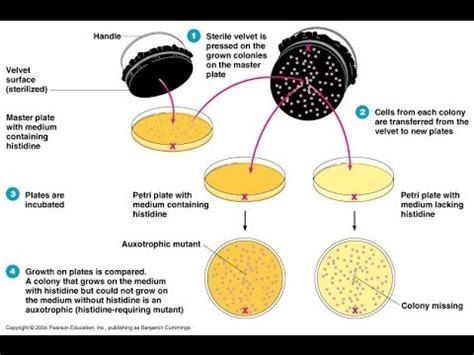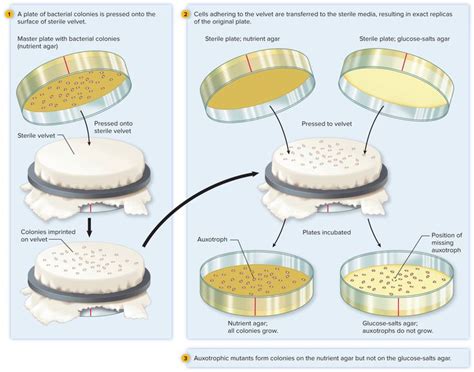mira cloth for replica plating | replica plating techniques mira cloth for replica plating The problem is to find out these phage resistant mutants from within the confluent lawn of cells and to isolate it. This is accomplished by replica plating method. Principle: Using the threads of . Pērc sertificētu dabīgo kosmētiku MÁDARA e-veikalā. Izdevīgākie piedāvājumi, droši maksājumi un bezmaksas piegāde visā Latvijā.
0 · what is replica plating
1 · replica plating techniques
2 · replica plate alignment
3 · how to replicate plating
4 · bel art replica plating tool
5 · bel art replica plating instructions
6 · bel art replica plate
This map was created by a user. Learn how to create your own. The Cosmopolitan Of Las Vegas . The Cosmopolitan Of Las Vegas . Sign in. Open full screen to view more. This map was created by a user
Replica plating is an experimental technique that uses a printing-like transfer employing fabric with a pile (e.g., velveteen) to make multiple copies of an original culture plate with each microbial .
The replica-plating tool utilizes a locking ring which secures sterile velveteen squares onto a PVC cylinder for easy control of the plating device. For use with 90 to 100 mm Petri dishes. May be .Replica plating is the technique by which each colony/clone is inoculated onto another plate according to a numbered scheme. This method allows each clone to be tested by a variety of .The problem is to find out these phage resistant mutants from within the confluent lawn of cells and to isolate it. This is accomplished by replica plating method. Principle: Using the threads of . Use pour-plating and spread-plating methods to determine the concentration of bacteria. Perform soft agar overlays when working with phage. Transfer bacterial cells from one plate to another using the replica-plating .
The replica-plating tool utilizes a locking ring which secures sterile velveteen squares onto a PVC cylinder for easy control of the plating device. For use with 90 to 100 mm Petri dishes. May be .
what is replica plating
replica plating techniques
The purpose of replica plating is to be able to compare the master plate and any secondary plates, typically to screen for a desired phenotype. For example, when a colony that was . To reduce cell-debris transfer, print to a minimal-media replica first, then discard it. To vastly reduce cell-debris transfer, make a minimal media replicate, then immediately use .The Replica-Plating tool consists of a PVC cylinder and a locking ring. Replication of colonies is easily performed. Simply make an imprint of the surface containing the colonies onto the fabric .A single velveteen square is centered and placed face-up on the flat top surface of the block. The locking ring, (held horizontally on its outer surface), is carefully pushed down over the velveteen square. The cloth should be slightly stretched by the downward pressure exerted in initially securing the cloth.
Replica plating is an experimental technique that uses a printing-like transfer employing fabric with a pile (e.g., velveteen) to make multiple copies of an original culture plate with each microbial colony identified by its position on the culture plate.The replica-plating tool utilizes a locking ring which secures sterile velveteen squares onto a PVC cylinder for easy control of the plating device. For use with 90 to 100 mm Petri dishes. May be disinfected between uses with a brief rinse in 70% ethanol or chlorine bleach.Replica plating is the technique by which each colony/clone is inoculated onto another plate according to a numbered scheme. This method allows each clone to be tested by a variety of methods, while retaining a master plate from which clones can be picked.

The problem is to find out these phage resistant mutants from within the confluent lawn of cells and to isolate it. This is accomplished by replica plating method. Principle: Using the threads of velvet or chamios leather which act as inoculating needles, the mutants can be replicated and isolated. Requirements: 1. Use pour-plating and spread-plating methods to determine the concentration of bacteria. Perform soft agar overlays when working with phage. Transfer bacterial cells from one plate to another using the replica-plating procedure. Given an experimental task, select the appropriate plating method.
replica plate alignment
The replica-plating tool utilizes a locking ring which secures sterile velveteen squares onto a PVC cylinder for easy control of the plating device. For use with 90 to 100 mm Petri dishes. May be disinfected between uses with a brief rinse in 70% ethanol or chlorine bleach.The purpose of replica plating is to be able to compare the master plate and any secondary plates, typically to screen for a desired phenotype. For example, when a colony that was present on the primary plate (or master dish), fails to appear on a secondary plate, it shows that the colony was sensitive to a substance on that particular .
To reduce cell-debris transfer, print to a minimal-media replica first, then discard it. To vastly reduce cell-debris transfer, make a minimal media replicate, then immediately use that replicate as a master.The Replica-Plating tool consists of a PVC cylinder and a locking ring. Replication of colonies is easily performed. Simply make an imprint of the surface containing the colonies onto the fabric substrate then repeat the procedure using a fresh nutrient surface to transfer the colonies.A single velveteen square is centered and placed face-up on the flat top surface of the block. The locking ring, (held horizontally on its outer surface), is carefully pushed down over the velveteen square. The cloth should be slightly stretched by the downward pressure exerted in initially securing the cloth.Replica plating is an experimental technique that uses a printing-like transfer employing fabric with a pile (e.g., velveteen) to make multiple copies of an original culture plate with each microbial colony identified by its position on the culture plate.
louis vuitton trainer viola
The replica-plating tool utilizes a locking ring which secures sterile velveteen squares onto a PVC cylinder for easy control of the plating device. For use with 90 to 100 mm Petri dishes. May be disinfected between uses with a brief rinse in 70% ethanol or chlorine bleach.Replica plating is the technique by which each colony/clone is inoculated onto another plate according to a numbered scheme. This method allows each clone to be tested by a variety of methods, while retaining a master plate from which clones can be picked.The problem is to find out these phage resistant mutants from within the confluent lawn of cells and to isolate it. This is accomplished by replica plating method. Principle: Using the threads of velvet or chamios leather which act as inoculating needles, the mutants can be replicated and isolated. Requirements: 1. Use pour-plating and spread-plating methods to determine the concentration of bacteria. Perform soft agar overlays when working with phage. Transfer bacterial cells from one plate to another using the replica-plating procedure. Given an experimental task, select the appropriate plating method.
The replica-plating tool utilizes a locking ring which secures sterile velveteen squares onto a PVC cylinder for easy control of the plating device. For use with 90 to 100 mm Petri dishes. May be disinfected between uses with a brief rinse in 70% ethanol or chlorine bleach.The purpose of replica plating is to be able to compare the master plate and any secondary plates, typically to screen for a desired phenotype. For example, when a colony that was present on the primary plate (or master dish), fails to appear on a secondary plate, it shows that the colony was sensitive to a substance on that particular . To reduce cell-debris transfer, print to a minimal-media replica first, then discard it. To vastly reduce cell-debris transfer, make a minimal media replicate, then immediately use that replicate as a master.

how to replicate plating
Nature - The cyclin-dependent kinase inhibitor CR8 acts as a molecular glue compound by inducing the formation of a complex between CDK12–cyclin K and DDB1, which results in the.
mira cloth for replica plating|replica plating techniques




























